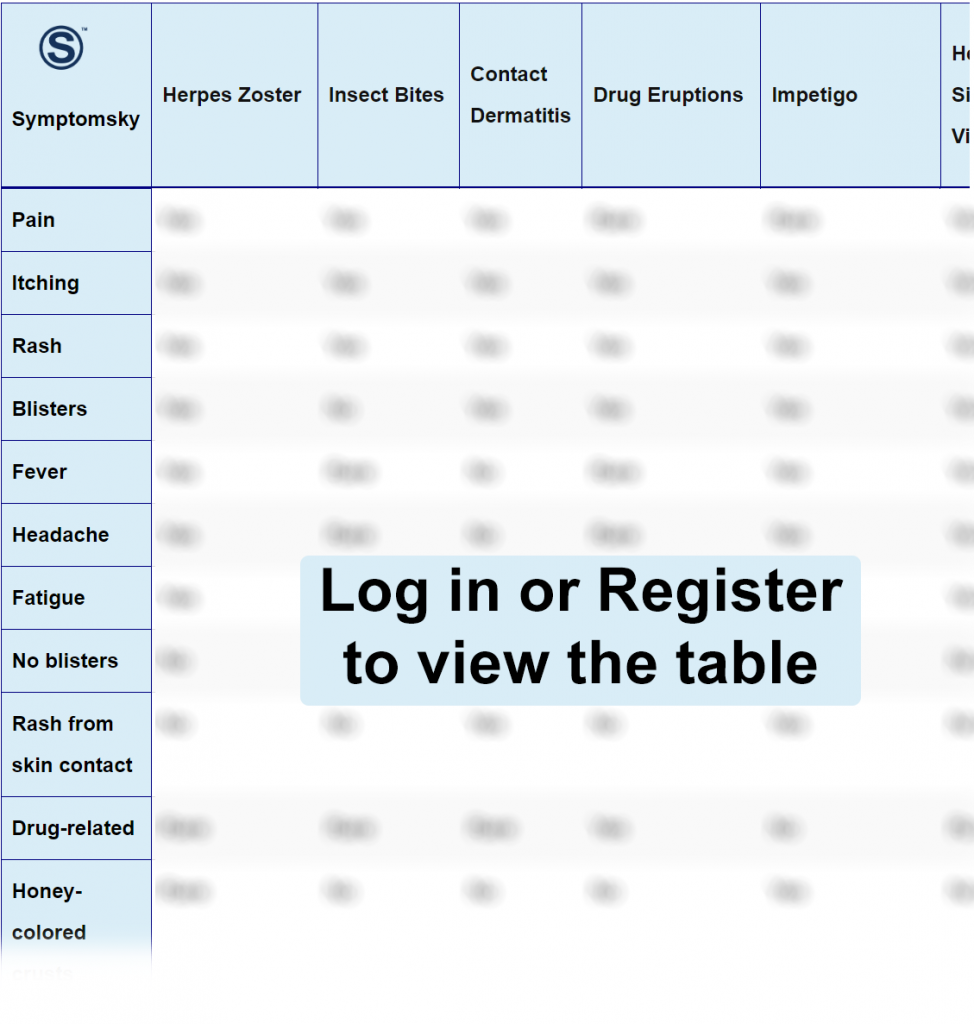Contents
- 1 Herpes Zoster Differential Diagnosis Table:
- 2 How to Distinguish Herpes Zoster from Other Diseases
- 2.1 Distinguish Insect Bites from Herpes Zoster – Diagnosis
- 2.2 Distinguish Contact Dermatitis from Herpes Zoster – Diagnosis
- 2.3 Distinguish Drug Eruption from Herpes Zoster – Diagnosis
- 2.4 Distinguish Impetigo from Herpes Zoster – Diagnosis
- 2.5 Distinguish Herpes Simplex Virus from Herpes Zoster – Diagnosis
- 2.6 Distinguish Candidiasis from Herpes Zoster – Diagnosis
- 2.7 Distinguish Dermatitis Herpetiformis from Herpes Zoster – Diagnosis
- 3 Herpes Zoster Red Flags and Treatment
Herpes Zoster Differential Diagnosis Table:

Herpes Zoster is a viral syndrome due to reactivation of varicella-zoster virus. Varicella zoster virus is an episode of chickenpox then it remains dormant in the nervous system. It is reactivated when the immune system defense fails.
Varicella zoster is diagnosed clinically as local inflammation and blistering (painful vesicles), appears on the face, torso, and neck. Blisters cause pain and a burning sensation. In addition to other symptoms such as fever, photophobia, malaise, and headaches. Varicella zoster is diagnosed by PCR, specific IgM antibodies when the virus is activated, and direct immunofluorescence.
Herpes zoster is painful and interferes with the patient’s life. Patients should be educated that this virus is strongly correlated with immune system status and it can be triggered by emotional stress and malignancy, immunosuppressants, and illness.
How to Distinguish Herpes Zoster from Other Diseases
Distinguish Insect Bites from Herpes Zoster – Diagnosis
- Insect bite is not associated with blistering, while blisters are a crucial symptom in herpes zoster.
- Insect bite has a pruritic eruption localized at the site of sting, unlike herpes zoster that is generalized blistering is neck, face, and torso.
Distinguish Contact Dermatitis from Herpes Zoster – Diagnosis
- Contact dermatitis is an inflammatory skin disease associated with contact irritants, while Herpes zoster is not associated with contact irritants.
“Patch testing is gold standard for differentiation.”
Distinguish Drug Eruption from Herpes Zoster – Diagnosis
- Drug eruption is skin manifestations due to systemic drug administration, while herpes zoster is not associated with causative agents.
“Patch testing and prick testing are used for differentiation.”
Distinguish Impetigo from Herpes Zoster – Diagnosis
- Impetigo is a bacterial infection, while herpes zoster is a viral infection.
- Impetigo has distinctive honey or yellow-colored crust, which is absent in herpes zoster.
“Bacterial culture and serological testing are used for differentiation.”
Distinguish Herpes Simplex Virus from Herpes Zoster – Diagnosis
- Herpes zoster is due to varicella-zoster virus, while herpes simplex is due to herpes simplex virus 1 or 2.
- Herpes zoster usually appears on the torso of one side of the body, while herpes simplex appears in the mouth or genitals.
“HSV serology is gold standard for differentiation, in addition to PCR, antibody assay, and viral culture.”
Distinguish Candidiasis from Herpes Zoster – Diagnosis
- Candidiasis is an opportunistic fungal infection, while Herpes zoster is a viral infection.
- Candidiasis affects the oral cavity or vagina, while Herpes zoster does not affect the oral cavity or vagina.
- Candidiasis is not associated with blisters, while herpes zoster’s crucial symptom is blisters.
“Microscopic examination is used for differentiation, along with physical examination.”
Distinguish Dermatitis Herpetiformis from Herpes Zoster – Diagnosis
Dermatitis herpetiformis is an autoimmune blistering disorder.
- Dermatitis herpetiformis is correlated to gluten ingestion, while herpes zoster is correlated to immunity status.
- Dermatitis herpetiformis appears on knees, buttocks, elbows, and scalp, unlike herpes zoster appears on torso, neck, and face.
- Dermatitis herpetiformis involves diarrhea and bloating, while herpes zoster does not involve any gastrointestinal symptoms.
“Serology and direct immunofluorescence are used for differentiation.”
Herpes Zoster Red Flags and Treatment
Complications may be present as secondary bacterial infection, post-herpetic neuralgia (which is persistent pain in the affected area after the vesicles are resolved), nerve palsy, hepatitis, and encephalitis.
Herpes zoster is treated through antiviral therapy of acyclovir 800mg 5 times/day for 8 days, in addition to topical antibiotics and analgesics for pain.
